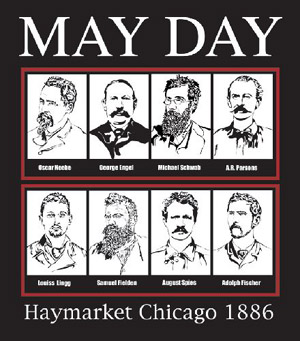Why we celebrate International Workers’ Day
Toward the end of the 19th century, the United States of America was home to many working people’s organizations. Two such organizations, the Knights of Labor and the Federation of Organized Trades and Labor Unions (later known as the American Federation of Labor), have competing stories from 1882 about one of their chapters proposing that the first Monday of September each year be observed as Labor Day.
Great battles for the eight-hour workday began two years later. The FOTLU held their national convention in Chicago and declared that “eight hours shall constitute a legal day's labor from and after May 1, 1886.” They planned and coordinated a series of demonstrations and labor strikes in order to win their demand.
On May 1, 1886, an estimated 300,000 workers across the nation went on strike, affecting more than 13,000 businesses. The population of the United States at that time was between 50 and 60 million.
In Chicago, where initially an estimated 40,000 workers went on strike, numbers soon swelled closer to 100,000. For two days, peace prevailed. On May 3, police brutalized striking workers and demonstrators at a picket outside the McCormick Reaper Works. Two died.
The day after, around 3,000 people gathered at Haymarket Square to decide what to do next. Speakers discouraged responding violently to the previous day’s killings and in later court proceedings the Mayor of Chicago would testify that the speeches and attendees were peaceful.
Police ordered the crowd to disperse and began marching to enforce the order. An unknown person threw a bomb into the police ranks. Police responded by firing on the crowd, killing an estimated seven to eight civilians and wounding scores more.
George Engel, Samuel Fielden, Adolph Fischer, Louis Lingg, Oscar Neebe, Albert Parsons, Michael Schwab and August Spies were convicted of murder in the criminal trial that followed from the incident. Only Fielden, Parsons and Spies were at Haymarket Square when the bomb exploded—the others had either departed by that time or were never there that day.
Witnesses testified to seeing Fielden, Parsons and Spies when the bomb was thrown and that none was the thrower.
Engel, Fischer, Parsons and Spies were hung to death on November 11, 1887. Lingg had taken his own life the night previous.
In 1889, a transnational organization of political parties and labor unions known as the Second International gathered in Paris and designated May 1 International Workers’ Day in memory of the wrongfully convicted and executed activitists. Today more than 150 countries observe International Workers’ Day.
A monument in a Forest Park, Ill., cemetery bears an epithet in the name of the Haymarket Martyrs.
THE DAY WILL COME WHEN OUR SILENCE WILL BE MORE POWERFUL THAN THE VOICES YOU ARE THROTTLING TODAY.
This is why, each year on May 1, we celebrate International Workers’ Day.

Comments
Post a Comment